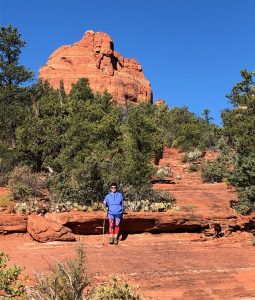After a four-month search, the Sedona Arts Center has found a new director: Julie Richard, who resigned from her position as executive director of the Maine Arts Commission to move to Sedona.
Former Sedona Arts Center director and artist Vince Fazio began working remotely in July, when he moved to Florida to spend time with his father. He was the director of SAC’s School of the Arts for 17 years, and also directed all programming and operations at the center during his three-year stint as executive director.
Fazio will continue to work as executive director until Richard officially begins on Monday, Jan. 18.
Though Richard is originally from Wisconsin, spent time in Upstate New York running the Syracuse opera, and most recently spent eight years in Augusta heading the Maine Arts Commission — yes, Maine has a big arts scene — she is no stranger to Arizona, or Sedona, for that matter.
She lived in the Phoenix area working for the West Valley Arts Council for a number of years and traveled to Sedona often with her husband, plein air artist Ed Buonvecchio.
“Arizona is a great place to be, especially Sedona,” Richard said. “Sedona is one of our favorite places on the planet, so it was kind of a no-brainer.”
Richard was already familiar with the Sedona Arts Center before she interviewed for the position.
“I’ve actually been following it for years, and have actually been on their mailing list and received their catalogue,” she said. “When I met the people, the board and the staff, I was just really excited about this opportunity.”
One thing she loves about the Sedona arts community is how much support there is for the center and artists, and vice versa.
“One of the things I’ve discovered over the years is that arts organizations are critically important to an artist community, but the artists are part and parcel,” she said. “The fact that the Sedona Arts Center supports so many artists in the area, and so many artists all over the world, is really important.”

Richard doesn’t plan on making any big changes to the center, which she says has been running smoothly, especially with the circumstances of a pandemic.
“They’ve got a successful business model now. I think that if anything I would just focus on what works now,” she said. “Anytime I go into an organization I like to do an assessment of how it operates and what works and what might need some tweaking, and I don’t have any preconceived notions that I’m going to change anything.”
Richard said that during the last few months she worked for the Maine Arts Commission, she spent time focusing on funding, raising additional money to support the artists there, bringing in professional development and advocacy.
“To handle the pandemic and deal with crises and situations during the pandemic, we also did a ton of surveying and getting the word out to economic development and elected officials so that they would have data to report back and potentially provide stimulus bills and funding,” she said.
Though the arts commission there was a government agency and did not have an on-site gallery or programs, Richard said that her history is mainly running 501(c)(3) nonprofit arts organizations, and she already has a good grip on how the Sedona Arts Center is looking on the cusp of what could be an even larger spike in area COVID-19 cases.
“I think they’ve done a great job of switching to online classes and an online gallery and store,” she said. “The hard work has been done.”
Richard said having the majority of SAC classes online should continue until a COVID-19 vaccine is readily available, after which Sedonans going back to in-person events and classes looks promising.
She is excited about a recent SAC survey, where around 4,000 area art patrons, mostly over age 70, responded. At least 50% said they would be willing to attend events right away after a vaccine was widely available. Around 40% reported that they would be willing to come back to in-person events within six months.
“I think it will be a little slow-going at first, but I think as people get comfortable, and the vaccine is wildly distributed and people gain confidence, I think we’ll see people slowly coming back,” she said. “And then, plus, it’s my understanding that the tourists really are back. That has actually been a positive for the arts center and has helped with sales in the gallery and the shop.”
Richard said that particularly since the COVID-19 situation, buying work directly from the artists is the best way to support them.
“I think one of the big threats that’s still out there is unemployment benefits are set to expire on Dec. 26, and all those artists that were laid off are going to have a really hard time once those benefits run out,” she said. “So supporting artists right now is critical.”
Richard will have some time to explore the area art galleries and maybe add some new pieces to the Cornville home she and her husband will be moving into right around Christmas.